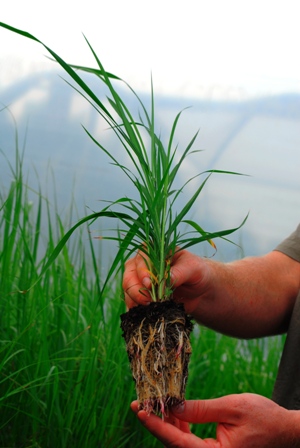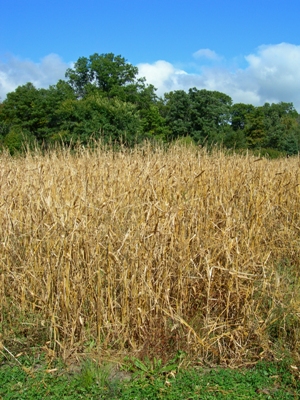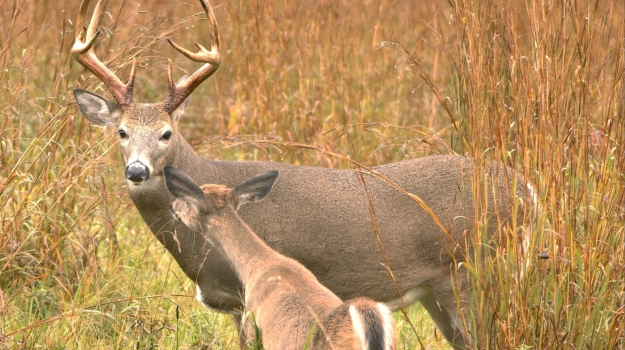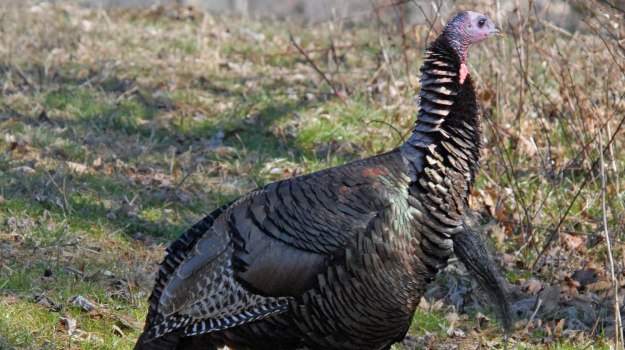Planting and Maintaining Native Warm Season Grasses
By Todd Amenrud
So many new whitetail managers have questions about food plots. Many “first-timers” begin because they want to attract more and bigger bucks to improve their hunting opportunities. I would tell them – sure, food plots will help to do that, BUT you must have other things going for you in addition to the new food or the impact probably won’t be what you expect. If you combine food plots with a reliable, clean water source, efficient living spaces and a sanctuary the results can be astounding! If you plant more food you attract more “mouths” to the area. But where are those deer going to live/bed? Creating extra living spaces can be done in several ways but one of the most productive procedures is planting grasses for cover.
Whitetails are very adaptable and live in many different types of habitat classifications. Timber stand improvement, planting trees, shrubs or grasses, disking to stimulate native seed banks and using fire can all be productive ways of creating the edge cover and diversity that whitetails love - and I suggest that a property manager consider all of the above. However, planting native warm season grasses (NWSG) is one of the tactics that I believe can show fast, significant and long lasting results. Ask a property owner who has been in CRP, CREP, WHIP, or one of the native grass restoration programs provided by the FSA or NRCS (Farm Service Agency or Natural Resources Conservation Service), how effective these perennial grass stands can be for providing cover to whitetails.
Much will depend upon your region, topography and the type of habitat you currently have. If you’re in the “big woods” and have a mature timber stand with a closed canopy then the chainsaw will probably produce the greatest, fastest results and in this case NWSG stands may actually be the wrong thing to do. However, if your property is located in farmland, marshland, riparian zone, rural area or new growth then native warm season perennial grasses can make a huge impact on how many deer you’re actually housing on your property.
 Native grass stands will work to provide whitetails with cover from Manitoba to Mississippi and from Wyoming to Virginia. The key word is “native.” You want to make sure the cultivar will grow in your region. I’ve been told by some that you want to purchase your NWSG seeds from a source within 200 miles of your location, but I have never adhered to that and I’ve experienced great results. Obviously there are certain cultivars that will grow in Minnesota that wouldn’t grow in, for instance, Texas. However, as long as you make sure the variety of plant will do well in your soil type and zone and as long as you give the plants what they need I think you’ll be fine.
Native grass stands will work to provide whitetails with cover from Manitoba to Mississippi and from Wyoming to Virginia. The key word is “native.” You want to make sure the cultivar will grow in your region. I’ve been told by some that you want to purchase your NWSG seeds from a source within 200 miles of your location, but I have never adhered to that and I’ve experienced great results. Obviously there are certain cultivars that will grow in Minnesota that wouldn’t grow in, for instance, Texas. However, as long as you make sure the variety of plant will do well in your soil type and zone and as long as you give the plants what they need I think you’ll be fine.
My good friend and wildlife manager, Austin Delano, is one of the best in the business when it comes to growing and killing mature bucks in the south. I asked him to tell me the importance of NWSG stands to him. Austin said, “Warm season grasses are a great management tool that I utilize here in the south. On a property where the makeup of the habitat is mostly mature hardwoods or pine plantations, warm season grasses provide fawning cover, bedding for mature deer, as well as great escape cover. Warm season grasses also can be used as a transition area between hardwoods, food plots, water sources, etc.” So NWSG stands can be important no matter where whitetails roam.
Tall, sturdy grasses, whether they are annual or perennial, can create fast, easy, inexpensive housing for your herd. Native grasses are one thing missing from many properties throughout the whitetails’ range. Again, it isn’t necessarily missing, or required on some properties. However, in the areas where native grass stands have historically grown oftentimes now-days they are absent.
Some of my favorites are annuals like Japanese millet, different varieties of sorghum, Peredovik sunflower, Egyptian wheat, and sometimes corn and various annual or biannual legumes. My favorite perennials include big bluestem, little bluestem, Indian grass, several varieties of switchgrass, Illinois bundleflower, side oats grama and several legumes. Obviously, not all of these are grasses, some are forbs or legumes. In fact, it is a good idea to blend legumes with these grass blends. Over the years I have gone from selecting specific individual legumes to incorporate with the grasses to simply mixing them with Clover Plus. With it I get a good mix of both, white and red perennial clovers and chicory and these cultivars will produce even with the competition of the grasses. In addition, these legumes will affix ample nitrogen that the grasses love.
One of the keys to many of these grasses, especially the perennials, is they grow in clumps rather than a thick matt. This allows other plants to also take root and thus promotes a diverse stand. This aspect also makes it so these stands become a great sanctuary for newly hatched quail, pheasants or turkeys because they can maneuver through and around the clumps protected from predators above.
I have tested different mixtures and blends over the years and really have had good luck with most of them. Even blends of all annuals help promote cheap, fast housing for your herd. The perennials, on the other hand, are NOT cheap, but a little can go a long way.
The perennials especially must be planted with care. You cannot simply “broadcast and go” like you can with some BioLogic blends, they must be planted and cared for properly.
Good stands can be produced with many different recipes and ratios of plants, but I like to use both annuals and perennials and I like to include grasses, legumes and forbs. The annuals shoot up fast so I really have a source of cover for my herd during the first year, and they (the annuals) seem to provide structure for the perennials as they develop. The annual seeds also help to evenly distribute some of the light, fluffy perennial seeds. Certain profound seed-producing annuals like millet, sorghum or Egyptian wheat (which is actually a variety of sorghum that grows very tall) may be prevalent for years. When the seed heads mature they will release thousands of seeds, and those that aren’t consumed by your wildlife are potential new plants for your stand.
Some choose to enlist the help of the NRCS or FSA and go strictly by the book. If you specifically want a native grass restoration this is a good idea, particularly if you have no experience. Establishing a NWSG stand takes knowhow and often special tools or techniques. But if you simply want “housing” for your whitetails, this can be a “do-it-yourself” project.
You must be precise in seedbed preparation. First, you should do a soil test and you must totally eliminate the existing competition. While glyphosate will work for this, I would suggest Plateau (Imazapic). It is the only herbicide that I know of that is devised specifically to control a wide range of unwanted grasses and broadleaf weeds, while allowing most native warm-season grasses to live. If you are doing one of those “by the book” projects with the NRCS or FSA you’ll definitely want to use Plateau. However, this herbicide can damage certain legumes and forbs and can sometimes be difficult to obtain. Journey is another herbicide that is easier to acquire. It’s a mixture of imazapic and glyphosate. It will kill the existing vegetation and provide residual control for several weeks after planting. These herbicides will kill some of the plants that I have listed, so read your herbicide instructions and know what you’re dealing with. Make sure that your herbicide is “kind” to the seeds you choose to plant.
You will want to prepare a flat, firm seedbed. These seeds can be broadcasted and most will have a planting depth of ¼ inch or less. If broadcasted, make sure to use a cultipacker to ensure good seed-to-soil contact. The ultimate would be a seeder specifically designed for NWSG plantings. Sometimes your county soil services office or local wildlife organization, such as a branch of QDMA or NWTF, may have one to rent. If using a drill you must be careful because some cannot be calibrated to evenly disperse these sometimes fluffy, odd-shaped seeds. Getting a bag of some of these NWSG seeds is more like receiving a pillow than a bag of seed.
I prefer to broadcast and cultipack. However, you must also be cautious here because the fluffy, lightweight or odd-shaped seeds will sometimes need a “carrier,” or a way to disperse the seeds evenly. If you just were to broadcast a hopper full of little bluestem seed, if you could get it to flow through the broadcaster it would likely just PUFF up into your face and go floating off into the wind. Some people use pelletized lime or fertilizer mixed with the seed to help it broadcast evenly. This is another reason why I like to mix these NWSG seeds with other types of seeds like annual grasses, legumes and forbs. These larger, denser seeds will help to distribute your NWSG seeds in place of the fertilizer or lime. Please don’t misunderstand me, you MUST still lime and fertilize according to a soil test, I’m simply talking about planting the seeds with a broadcaster.
Sometimes the vibration of the seeder will encourage seed separation because of the different size, shape and weight of the seeds, so make sure you mix the seeds well and stop periodically to mix again if you have a big plot to cover. I also suggest mixing in DeltAg’s Seed Coat when you do this.
 During the first growing season your annuals like the millet and Egyptian wheat will look to be the most dominant in the stand, but the perennials should be coming up underneath. Make sure to fertilize well when you plant because once the grasses get tall it will be difficult to fertilize a second time.
During the first growing season your annuals like the millet and Egyptian wheat will look to be the most dominant in the stand, but the perennials should be coming up underneath. Make sure to fertilize well when you plant because once the grasses get tall it will be difficult to fertilize a second time.
The second year (starting in the spring) fertilizer should be applied again. During May through July I suggest that you mow the plot several times, but stop mowing during July in the north, to as late as the end of August in the south and let your perennials come through. Your perennial warm season grasses should flourish during this time.
The following spring you may need to mow again, but after the second or third year you will want to treat the stand with fire. Burning during the spring (March in south to April in the North) will help to remove clutter and promote new growth on your NWSG, which in turn encourages wildlife utilization. A prescribed burn should be done every two to three years. If you cannot burn, sometimes mowing or disking can keep the woody litter to a minimum. If nothing is done and it’s left idle, too much plant refuse will develop over time which can impede plant growth and wildlife use. However, in my opinion, even an un-maintained grass stand is better than no grass stand at all!
A great way to get a jump on smaller NWSG plots is to purchase plugs. These already have a year of growth under their belt and they work great for smaller areas or situations where you don’t need a lot. Plugs will work great for an area of security cover near a food plot, to incorporate some tall grasses for a visual screen along a roadway or to add NWSG to a transition area or ecotone around a food plot. Nativ Nurseries dabbled in planting switchgrass, big bluestem, and Indian grass last year and sold plugs that can be transplanted wherever you would like. It was such a success that you can now purchase them through the website. While planting vast areas may get expensive this way, these plugs are ideal for planting logging decks, visual screens, ecotones around a food plot or creating connections between two areas. Contact Nativ Nurseries for availability at NativNurseries.com or call (662) 494-4326.
NWSG species can also be a great tool to help prevent erosion. For instance, species such as big bluestem can have a tap root over 10-feet deep! They can hold together levies that restrain flood waters, prevent roadside ditches from washing out and hold steep ridge sides in place. Since these NWSG spread by their rhizomes they are a great choice for erosion control.
There are three basic ways that I like to utilize these grasses. Simply creating living areas/bedding areas is probably the most considerable use. These areas tend to be larger areas, 5 acres to 40 acres or more in size. My goal is simply to provide living spaces for as may deer as possible. Knowing that whitetails really prefer “edge cover,” if the area is large I will likely break it up by planting smaller tree plots within the NWSG stand. Tree variety would vary depending on property location and manager’s goals, but I really like the addition of conifers that will absorb the heat from the sun to help provide winter thermal cover.
I also love to use NWSG to produce security cover near my food plots. Whether it’s a large feeding plot or a smaller hunting plot regardless, I will try to have some form of security cover nearby. These grasses can also be planted around the perimeter of the plot to create an ecotone that will help put your herd at ease when entering the plot. It is shown that a buffer area like this and security cover adjacent to the plot will promote earlier utilization so you will see more mature bucks earlier in the day and they will tend to spend more time in the plot.
Another great use is to plant NWSG strips as a screen to prevent view into an area or as connectors between two areas. If you have roadways open to view your property or nosey neighbors, NWSG strips alone, or in combination with other trees, or plants can make a fast screen to prevent view into your property. They are also valuable when needing a connector from one area of your land to another or from one form of structure to another. NWSG corridors can be created much faster than lanes of trees can be established. I would suggest that the combination of trees and the grasses make for the best bet, but the grasses will be productive right away while your trees establish. These little avenues can make it easy to sneak into a treestand or slip up on a gobbler undetected.
There are many different habitat manipulations we can do to enhance habitat for whitetails. But planting NWSG can be one of the fastest producing and bestow the biggest benefits, let alone for whitetails but for many species of wildlife, we didn’t even cover the huge assistance they are in providing cover for ground nesting birds. Maybe NWSG plots are missing on your property. As long as you prepare properly, use sound planting procedures and maintain the crop correctly you can realize the benefit of these “miracle grasses” and give your whitetails fast, efficient “housing.”
Header photo credit: Bruce Macqueen | Dreamstime.com
Thumbnail photo credit: Twildlife | Dreamstime.com




























